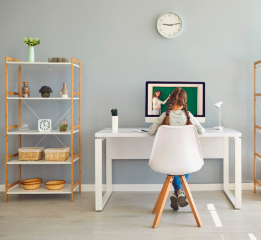With more students and professionals working from home, creating an effective learning space is key to fostering productivity and concentration. Whether you’re homeschooling, studying online, or working remotely, having the right environment can make all the difference. Here are some friendly and simple tips to help you set up your ideal learning space at home.
1. Choose the Right Location
The first step in creating a home learning space is choosing the right location. Look for a quiet spot that minimizes distractions. If you have kids or pets, try to place your study area in a part of the house where you can focus. Ideally, pick a location with natural light to create a pleasant atmosphere that promotes productivity.
Pro tip: If you’re limited on space, even a small corner can work—just make sure it feels cozy and free of distractions!
2. Invest in Comfortable Furniture
Comfort is essential for long hours of study or work. Invest in a comfortable chair and desk that support good posture. A good chair will help prevent back and neck pain, which can be common when sitting for long periods. The desk should provide ample space for your computer, books, and any other learning materials.
Bonus tip: Ergonomic furniture can be a game-changer when it comes to maintaining comfort throughout the day.
3. Keep It Organized
Clutter can be a major source of stress and distraction. Make sure your home learning space is tidy and well-organized. Use shelves, bins, or drawers to store materials like books, papers, or electronics. Keeping everything in its place ensures that you can stay focused on the task at hand.
Tip: A clutter-free desk will help you stay focused and can even improve your mood while studying.
4. Lighting is Key
Proper lighting is crucial for reducing eye strain, especially when working on a computer or reading for long periods. Ensure your learning space is well-lit, ideally with a combination of natural and artificial light. A desk lamp with adjustable brightness can be a great addition.
Did you know? Lighting affects your mood. Bright, white lights can energize you, while warmer lighting may help you relax during breaks.
5. Personalize Your Space
Make your learning environment enjoyable by adding personal touches. This could be a few plants to bring some greenery into the room, a motivational poster, or even a cozy blanket for comfort. When your space reflects your personality, it becomes a more inviting and motivating place to study.
Tip: Personalizing your space doesn’t mean overdecorating. Choose a few items that bring you joy and motivation.
6. Minimize Distractions
Distractions can come from anywhere—whether it’s the sound of a TV in the next room or your phone buzzing with notifications. To combat this, consider using noise-canceling headphones, or set specific hours for focused learning time without interruptions. Turning off unnecessary apps or using a website blocker can also help you stay on track.
Focus tip: Create a schedule to limit distractions and build a habit of focusing during dedicated study hours.
7. Create a Relaxation Zone
While it’s important to focus on your work, it’s equally important to have a space to unwind. Incorporating a small relaxation area, like a comfy chair for reading or a space for light stretching, can help rejuvenate you during breaks.
Relaxation reminder: Breaks are essential to keeping your mind fresh and avoiding burnout.
Conclusion
Creating a productive home learning space is all about balance—comfort, organization, and personalization. With the right setup, you can turn your home into a place that fosters learning, creativity, and productivity. Remember, even small changes to your environment can have a significant impact on how well you focus and work.














